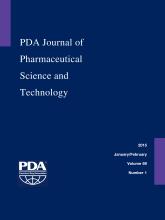Abstract
Elemental impurities in drug products can arise from a number of different sources and via a number of different means, including the active pharmaceutical ingredient, excipients, the vehicle, and leaching of elemental entities that are present in the drug product's manufacturing or packaging systems. Thus, knowledge about the presence, level, and likelihood of leaching of elemental entities in manufacturing and packaging systems is relevant to understanding how these systems contribute to a drug product's total elemental impurity burden. To that end, a joint team from the Extractables and Leachables Safety Information Exchange (ELSIE) Consortium and the International Pharmaceutical Aerosol Consortium on Regulation and Science (IPAC-RS) has conducted a review of the available literature on elemental entities in pharmaceutically relevant polymers and the presence of these elemental entities in material extracts and/or drug products. This review article contains the information compiled from the available body of literature and considers two questions: (1) What elemental entities are present in the relevant polymers and materials and at what levels are they present? (2) To what extent are these elemental entities leached from these materials under conditions relevant to the manufacturing and storage/distribution of solution drug products? Conclusions drawn from the compiled data are as follows: (1) Elemental entities are present in the materials used to construct packaging and manufacturing systems as these materials either contain these elemental entities as additives or are exposed to elemental entities during their production. (2) Unless the elemental entities are parts of the materials themselves (for example, SiO2 in glass) or intentionally added to the materials (for example, metal stearates in polymers), their incidental amounts in the materials are generally low. (3) When elemental entities are present in materials and systems, generally only a very small fraction of the total available amount of the entity can be leached under conditions that are relevant to packaged drug products. Thus, while sources of certain elemental impurities may be ubiquitous in the natural environment, they are not ubiquitous in materials used in pharmaceutical packaging and manufacturing systems and when they are present, they are not extensively leached under relevant conditions. The information summarized here can be utilized to aid the elemental impurity risk assessment process by providing the identities of commonly reported elements and data to support probability estimates of those becoming elemental impurities in the drug product. Furthermore, recommendations are made related to establishing elements of potential product impact for individual materials.
LAY ABSTRACT: Extraneous impurities in drug products provide no therapeutic benefit and thus should be known and controlled. Elemental impurities can arise from a number of sources and by a number of means, including the leaching of elemental entities from drug product packaging and manufacturing systems. To understand the extent to which materials used in packaging systems contain elemental entities and the extent to which those entities leach into drug products to become elemental impurities, the Extractables and Leachables Safety Information Exchange (ELSIE) and International Pharmaceutical Aerosol Consortium on Regulation and Science (IPAC-RS) Consortia have jointly performed a literature review on this subject. Using the compiled information, it was concluded that while packaging materials may contain elemental entities, unless those entities are intentional parts of the materials, the amounts of those elemental entities are generally low. Furthermore, generally only a very small fraction of the total available amount of the entity can be leached under conditions that are relevant to packaged drug products. Thus, risk assessment of sources of elemental impurities in drug products that may be related to materials used in pharmaceutical packaging and manufacturing systems can utilize the information and recommendations presented here.
- Elemental impurities
- Polymers
- Pharmaceutical manufacturing systems
- Packaging systems
- Extractables
- Leachables
Footnotes
Extractables and Leachables Safety Information Exchange (ELSIE), Washington, DC.
International Pharmaceutical Aerosol Consortium on Regulation and Science (IPAC-RS), Washington, DC.
Observations made, opinions expressed and conclusions drawn in this article reflect the views of the authors acting in their role as participants in ELSIE and IPAC-RS and should not be construed to represent the views or policies of their affiliated organizations.
- © PDA, Inc. 2015
PDA members receive access to all articles published in the current year and previous volume year. Institutional subscribers received access to all content. Log in below to receive access to this article if you are either of these.
If you are neither or you are a PDA member trying to access an article outside of your membership license, then you must purchase access to this article (below). If you do not have a username or password for JPST, you will be required to create an account prior to purchasing.
Full issue PDFs are for PDA members only.
Note to pda.org users
The PDA and PDA bookstore websites (www.pda.org and www.pda.org/bookstore) are separate websites from the PDA JPST website. When you first join PDA, your initial UserID and Password are sent to HighWirePress to create your PDA JPST account. Subsequent UserrID and Password changes required at the PDA websites will not pass on to PDA JPST and vice versa. If you forget your PDA JPST UserID and/or Password, you can request help to retrieve UserID and reset Password below.






